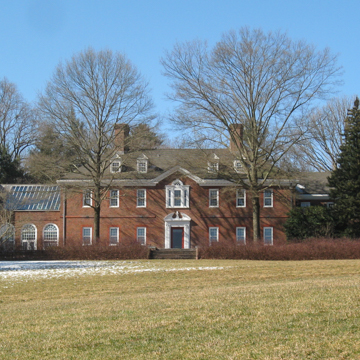Colonial Williamsburg defined the style of this home, built by Lammot du Pont Copeland and his wife, Pamela Cunningham Copeland. The hilly district, said to have been named for a locale in Ireland, was a popular picnic area even before the Wilmington and Western Railroad (CH30) established a station nearby in 1872. Pamela liked the 400-foot hill, among Delaware's highest, for its resemblance to places in her native New England, and they built their Georgian Revival mansion in a cornfield near the summit. It was one of the first commissions of the Homsey firm, relatives of Lammot. On a frame of steel and concrete, the Homseys erected walls of Williamsburg Genuine Handmade Colonial Brick, manufactured by C. H. Locher of Glasgow, Virginia—just like the bricks used in restoring the Williamsburg Gaol in 1935. Paneling of outstanding quality was brought in from colonial homes in the Carolinas, Massachusetts, New Hampshire, and Virginia, with a stair (c. 1800) from Charleston. American Car and Foundry repaired and painted the paneling in its Wilmington plant. The living room contains bold paneling from the Old Brick House, Pasquotank County, North Carolina: Ionic pilasters and a huge scroll above the fireplace, that Winterthur Museum director Charles F. Montgomery traced to Batty Langley's Builder's Jewel (1751). (Ties were always close between the Copelands and Winterthur, CH10.) The conservatory has a trompe l'oeil latticework mural (1953, Robert Bushell). Lammot, an arts enthusiast who once had Salvador Dali paint his portrait, was the son of the woman who founded the Delaware Art Museum (WL90), the facade of which would imitate this conservatory. Lammot liked to shoot in the pistol range in the Mt. Cuba basement. The mansion became widely known: it was featured in Antiques (October 1952) and in a book, The One Hundred Most Beautiful Rooms in America (1958). Following Pamela's death here at age ninety-four in 2001, Sotheby's auctioned the furniture for $12.5 million, a symbolic end to the great twentieth-century era of du Pont family collecting.
Philadelphia landscape architect Thomas Sears, designer of many estates, met with the Homseys as early as December 1935 to discuss the integration of house and grounds. His major contributions were the forecourt with its Williamsburg-like walls, sweet gum allee, lilac allee, and also the south terrace and cutting garden. The formal gardens of the south terrace are among the last by Marian Coffin, who had designed Lammot's grandparents' garden at St. Amour in 1918 (CH23). She reworked Sears's south terrace and added a Round Garden. Pamela Copeland developed a naturalistic garden in the 1960s that became famous. Following Mrs. Copeland's wishes, Mt. Cuba has been restored as a center for the study of Piedmont flora. Its hand-wrought entrance gates replicating trees and plants are by Greg Leavitt of Berks County, Pennsylvania.


